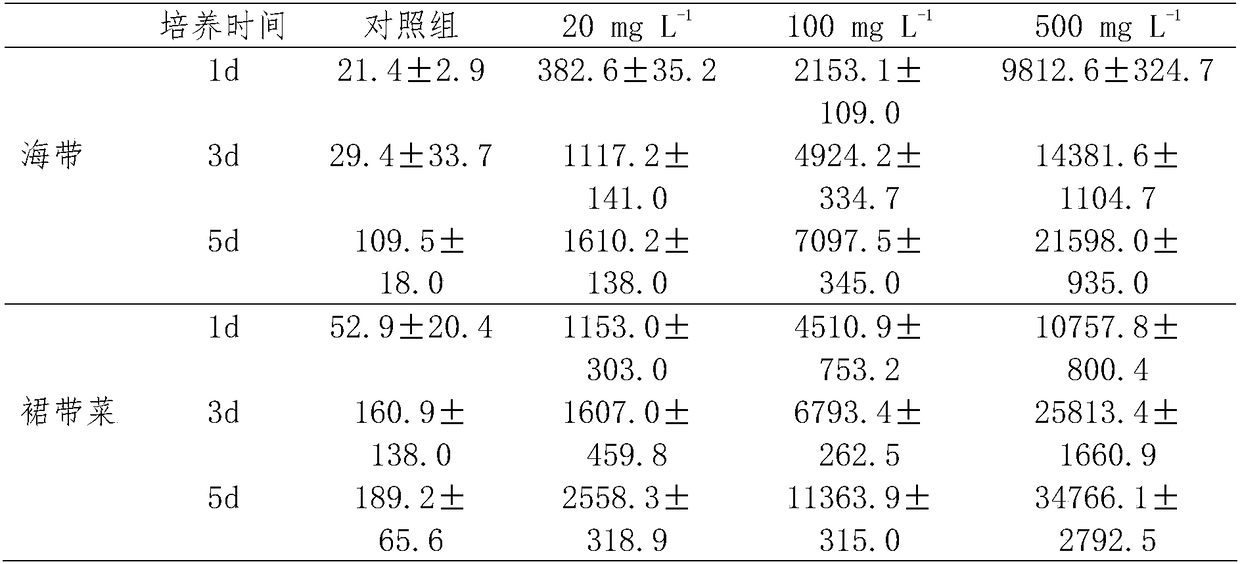Method for repairing nuclide cesium pollution of seawater
A seawater and nuclide technology, applied in the field of remediation of nuclide pollution, can solve rare problems, and achieve the effects of low cost, simple and easy remediation and recovery and high efficiency.
- Summary
- Abstract
- Description
- Claims
- Application Information
AI Technical Summary
Problems solved by technology
Method used
Image
Examples
Embodiment 1
[0022] Comparison and Screening of Cesium Adsorption Capability of Different Seaweeds
[0023] Five species of seaweed larvae that are common in coastal areas of my country and have large biomass were selected: sea millet (Sargassum muticum), sage (Sargassum thunbergii), true gracilaria (Gracilaria vermiculophylla), kelp (Saccharina japonica) and wakame (Undaria pinnitafida) ). Take an appropriate amount of live seaweed into a 1L beaker, and add different concentrations of cesium (20, 100 and 500mg L -1 ), the natural seawater without cesium was used as the control group, and each group of experiments was set up with 3 parallels; the temperature was 15 °C, and the light intensity was 50 μmol photons m -2 s -1 , Light cycle 12h (L): 12h (D) in the incubator for aeration culture, cultured for 3 days, take out an appropriate amount of algal samples, and detect the content of cesium in the algae under different cesium concentrations by ICP-OES (Table 1).
[0024] Table 1 Compari...
Embodiment 2
[0028] Comparison of cesium adsorption capacity between kelp and wakame seedlings
[0029] Take kelp larvae or wakame larvae with a length of about 15cm and place them in a 1L beaker, and place them at a temperature of 15°C and a light intensity of 50μmol photons m -2 s -1 , light cycle 12h (L): aerated culture in an incubator for 12h (D); the incubator contains cesium (20, 100 and 500 mg L of different concentrations) -1 ) beakers of natural seawater were used as the experimental group, or the beakers only filled with natural seawater as the control group. Each group of experiments was set up in 3 parallels, and the water was changed every day. After culturing for 1, 3, and 5 days, take out an appropriate amount of kelp and wakame samples. ICP-OES detects the content of cesium in the algae under different conditions (see Table 2); wherein, the concentration of cesium in the natural seawater is 24 ± 5 μg L -1 , which is negligible compared to the added cesium concentration...
Embodiment 3
[0034] Example 3 Water tank simulation experiment for removing cesium ions from adult kelp
[0035] Into a 148L glass tank, live adult kelp (52.7g / L) with a fresh weight of about 7.8kg (about 2.6kg / tree) was added for aeration culture, and cesium chloride was added to the seawater in advance, so that the initial concentration of cesium was 143mg L -1 (measured value), take seawater samples at 1, 2, 3, 6, 8, 12, 24, and 48 hours of treatment, respectively, to detect the cesium content (see figure 1 ).
[0036] Depend on figure 1 The results show that under artificial simulation conditions, the restoration process of kelp to seawater nuclide cesium is basically completed within 24 hours, and then the algae can be recovered and treated, and fresh kelp is added again until the cesium in seawater is completely removed.
[0037] It can be seen from the above Example 3 that the water tank model can simulate the process of using live seaweed to reduce the concentration of nuclides i...
PUM
 Login to View More
Login to View More Abstract
Description
Claims
Application Information
 Login to View More
Login to View More - Generate Ideas
- Intellectual Property
- Life Sciences
- Materials
- Tech Scout
- Unparalleled Data Quality
- Higher Quality Content
- 60% Fewer Hallucinations
Browse by: Latest US Patents, China's latest patents, Technical Efficacy Thesaurus, Application Domain, Technology Topic, Popular Technical Reports.
© 2025 PatSnap. All rights reserved.Legal|Privacy policy|Modern Slavery Act Transparency Statement|Sitemap|About US| Contact US: help@patsnap.com



